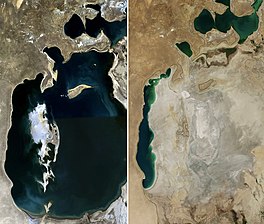
Back Aralmeer Afrikaans አራል ባሕር Amharic Mar d'Aral AN بحر آرال Arabic Mar d'Aral AST Aral gölü Azerbaijani آرال گؤلو AZB Арал диңгеҙе Bashkir Segara Aral BAN Arala jūra BAT-SMG
| Aral Sea | |
|---|---|
| |
 The Aral Sea in 1989 (left) and 2014 (right) | |
| Location | Central Asia (Kazakhstan – Uzbekistan) |
| Coordinates | 45°N 60°E / 45°N 60°E |
| Type | Endorheic, natural lake, reservoir (North) |
| Primary inflows |
|
| Catchment area | 1,549,000 km2 (598,100 sq mi) |
| Basin countries | |
| Surface area |
|
| Average depth |
|
| Max. depth |
|
| Water volume | North: 21.4 km3 (5 cu mi) (2024)[3] |
| Surface elevation |
|
The Aral Sea (/ˈærəl/)[5][a] was an endorheic lake (that is, without an outlet) lying between Kazakhstan to its north and Uzbekistan to its south, which began shrinking in the 1960s and had largely dried up by the 2010s. It was in the Aktobe and Kyzylorda regions of Kazakhstan and the Karakalpakstan autonomous region of Uzbekistan. The name roughly translates from Mongolic and Turkic languages to "Sea of Islands", a reference to the large number of islands (over 1,100) that once dotted its waters. The Aral Sea drainage basin encompasses Uzbekistan and parts of Afghanistan, Iran, Kazakhstan, Kyrgyzstan, Tajikistan, and Turkmenistan.[1]
Formerly the third-largest lake in the world with an area of 68,000 km2 (26,300 sq mi), the Aral Sea began shrinking in the 1960s after the rivers that fed it were diverted by Soviet irrigation projects. By 2007, it had declined to 10% of its original size, splitting into four lakes: the North Aral Sea, the eastern and western basins of the once far larger South Aral Sea, and the smaller intermediate Barsakelmes Lake.[6] By 2009, the southeastern lake had disappeared and the southwestern lake had retreated to a thin strip at the western edge of the former southern sea. In subsequent years occasional water flows have led to the southeastern lake sometimes being replenished to a small degree.[7] Satellite images by NASA in August 2014 revealed that for the first time in modern history the eastern basin of the Aral Sea had completely dried up.[8][9] The eastern basin is now called the Aralkum Desert.
In a Kazakhstani effort to save and replenish the North Aral Sea, the Dike Kokaral dam was completed in 2005. By 2008, the water level had risen 12 m (39 ft) above that of 2003,[2] to 42 m (138 ft).[10] As of 2013[update], salinity dropped, and fish were again present in sufficient numbers for some fishing to be viable.[11]
After the visit to Muynak in 2011, former United Nations Secretary General Ban Ki-moon called the shrinking of the Aral Sea "one of the planet's worst environmental disasters".[12] The region's once-prosperous fishing industry has been devastated, bringing unemployment and economic hardship. The water from the diverted Syr Darya river is used to irrigate about two million hectares (5,000,000 acres) of farmland in the Ferghana Valley.[13] The Aral Sea region is heavily polluted, with consequent serious public health problems. UNESCO has added historical documents concerning the Aral Sea to its Memory of the World Register as a resource to study the environmental tragedy.
- ^ a b "DRAINAGE BASIN OF THE ARAL SEA AND OTHER TRANSBOUNDARY SURFACE WATERS IN CENTRAL ASIA" (PDF). United Nations Economic Commission for Europe (UNECE). 2005. Retrieved 4 February 2016.
- ^ a b "The Kazakh Miracle: Recovery of the North Aral Sea". Environment News Service. 1 August 2008. Archived from the original on 12 April 2010. Retrieved 22 March 2010.
- ^ Abuova, Nagima (24 June 2024). "Water Volume Rises in Northern Aral Sea, Hits 21.4 Billion Cubic Meters". The Astana Times. Archived from the original on 28 June 2024. Retrieved 14 November 2024.
- ^ JAXA. "South Aral Sea shrinking but North Aral Sea expanding"
- ^ "Aral Sea | Definition of Aral Sea in English by Lexico Dictionaries". Archived from the original on 31 January 2018.
- ^ Philip Micklin; Nikolay V. Aladin (March 2008). "Reclaiming the Aral Sea". Scientific American. Retrieved 17 May 2008.
- ^ "Satellite image, August 16, 2009 (click on "2009" and later links)". 24 September 2014.
- ^ Liston, Enjoli (1 October 2014). "Satellite images show Aral Sea basin 'completely dried'". The Guardian. London: Guardian News and Media Limited. Retrieved 1 October 2014.
- ^ Rosenberg, Matt (8 December 2022). "Why Is the Aral Sea Shrinking?". ThoughtCo. Archived from the original on 29 June 2022. Retrieved 19 September 2022.
- ^ Stephen M Bland. "Central Asia Caucasus". stephenmbland.com.
- ^ "Aral Sea Reborn". Al Jazeera. 21 July 2012. Retrieved 6 January 2013.
- ^ "Aral Sea 'one of the planet's worst environmental disasters'". The Daily Telegraph. London. May 2010. Archived from the original on 8 April 2010.
- ^ "Syr Darya river, Central Asia". Encyclopedia Britannica. 19 July 2023.
Cite error: There are <ref group=lower-alpha> tags or {{efn}} templates on this page, but the references will not show without a {{reflist|group=lower-alpha}} template or {{notelist}} template (see the help page).
